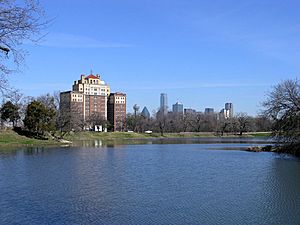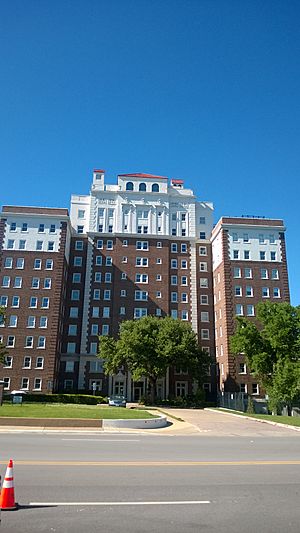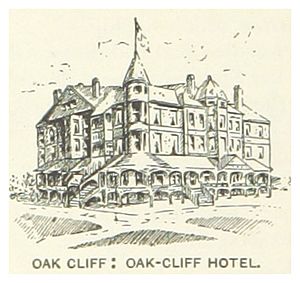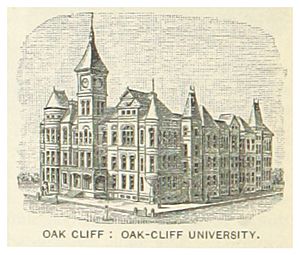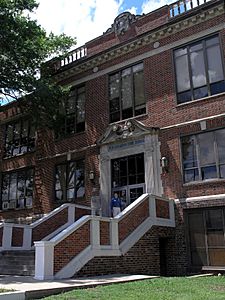Oak Cliff facts for kids
Oak Cliff is a well-known area in Dallas, Texas, USA. It used to be its own town, founded in 1886. Later, in 1903, it became part of Dallas. Even though it's now part of a bigger city, Oak Cliff still feels like a unique neighborhood with its own history and identity.
This area is known for its homes built in the early 1900s and mid-1900s. It has many parks and is very close to the main part of downtown Dallas. Oak Cliff is generally bordered by Interstate 30 to the north, Loop 12 to the west, Interstate 35E to the east, and the Trinity River to the northeast. Interstate 20 is to the south.
Contents
The Story of Oak Cliff
How Oak Cliff Began
Oak Cliff started on December 15, 1886. Two men, John S. Armstrong and Thomas L. Marsalis, bought a large farm. They paid $8,000 for about 320 acres (1.3 km²). They divided the farm into smaller blocks to create a new town.
Their plan was to build a fancy neighborhood, and it worked! By the end of 1887, they had sold over $60,000 worth of land. The two partners later disagreed, and Marsalis took full control of developing Oak Cliff. Armstrong then went on to create his own upscale neighborhood in Dallas called Highland Park.
The first map of Oak Cliff showed it stretching from what is now Colorado Boulevard in the north to below Thirteenth Street in the south. It was bordered by Cliff Street to the east and Beckley Avenue to the west. Jefferson Boulevard was a steam railroad track, and Marsalis Avenue was the main north-south road.
Early Growth and Fun Parks
In November 1887, people quickly bought lots in the new Marsalis Addition. Over $23,000 worth of land sold before noon on one day! The next day, 91 more lots sold for over $38,000. By the end of November, Oak Cliff had about 500 people.
Marsalis built the Oak Cliff Elevated Railway to help people get to his new area. It was promoted as the "first elevated railway in the South." This train mostly ran on the ground along Jefferson Boulevard, only becoming slightly elevated when it crossed the Trinity River. It was used by people going to work and those looking for fun.
Marsalis also wanted Oak Cliff to be a vacation spot. He created Oak Cliff Park, which later became Marsalis Park and Zoo. This park was huge, about 150 acres (0.6 km²), and had a two-mile (3 km) long lake. It also had a large pavilion that could hold 2,000 people for dances and operas.
He also built the Park Hotel, which was like a famous hotel in San Diego. It had special mineral baths with water from underground wells.
Becoming a Town
Oak Cliff officially became a town in 1890, with a population of 2,470 people. It got its own post office, which operated until 1896. The town had several grocery stores, meat markets, a hardware store, and a feed store. There were also businesses like the Texas Paper Mills Company and the Oak Cliff Ice and Refrigeration Company.
More fancy neighborhoods were built, pushing the town's borders further west. Hugh Ewing was Oak Cliff's first mayor. In 1891, the town got its first newspaper, the Oak Cliff Sunday Weekly.
Challenges and Changes
Development continued for a few years, but a tough economic time in 1893 slowed things down. People weren't looking for vacation resorts as much, and Marsalis faced financial trouble. The Park Hotel was even turned into the Oak Cliff College for Young Ladies.
By 1900, Oak Cliff was changing. It was no longer just a fancy vacation spot. Many of the land lots were sold to middle and working-class families, a trend that continued into the early 1900s. The population reached 3,640 by 1900.
In 1902, an electric streetcar line was built through Oak Cliff, connecting Dallas to Fort Worth. This service stopped in the late 1930s. Smaller streetcar lines also ran throughout Oak Cliff's neighborhoods, covering over 20 miles (32 km). These streetcar paths helped create the unique twists and turns you see in Oak Cliff's roads today. Local streetcar service ended in 1956.
Joining Dallas and a Big Flood
Oak Cliff became part of Dallas in 1903. Dallas had tried to annex Oak Cliff since 1900, but it wasn't successful until the town's economy was struggling. This led to a vote, and annexation passed by just 18 votes.
In April 1908, the Trinity River flooded badly. The water rose very high, and the only bridge connecting Oak Cliff to Dallas was damaged. This led to the idea of building a new, stronger bridge. The Houston Street Viaduct (originally called the Oak Cliff Viaduct) was started in 1910 and opened in 1912. It was celebrated as one of the longest concrete bridges in the world.
In 1909, a big fire in Oak Cliff destroyed 14 blocks of homes.
A Time of Change and Challenges
During the Great Depression, Dallas's economy suffered. Many people in Oak Cliff, especially the Black community, faced unemployment and a need for affordable housing. This led to difficult times and discussions about housing and fairness.
On April 2, 1957, a tornado hit Oak Cliff. It caused a lot of damage and sadly, 10 people lost their lives.
Neighborhoods in Oak Cliff
Oak Cliff has many different neighborhoods, each with its own feel. Here are some of them:
- Arcadia Park
- Beckley Club Estates
- Beverly Hills
- Bishop Arts District
- Brentwood
- Brettonwoods
- Bronx Park
- Brooklyn Heights
- Carver Heights
- Cedar Haven
- Cedar Oaks
- Crestwood
- Dells District
- Druid Hills
- Elmwood
- El Tivoli Place
- Encinos Park
- Five Mile (Dallas)
- Glen Oaks (Dallas)
- Hampton Hills
- Hideaway Valley
- Kernwood
- Kessler Circle
- Kessler Highlands
- Kessler Park
- Kessler Plaza, Dallas
- Kiest - Polk
- Kiest Square
- Kiestwood
- Kimball Estates
- Kings Highway Conservation District
- Kidd Springs
- Lake Cliff
- Las Haciendas (Marion dr)(Dallas)
- Las Villas (Dallas)
- Legendary Hollow
- Los Encinos
- Loupot Heights
- L.O. Daniel
- Mountain Creek (Dallas)
- North Bishop Avenue Commercial Historic District
- North Cliff
- Oakland Terrace
- Oakland Hills, Woodtown
- Oak Park Estates
- Oak Tree Colony (The Countrytown)
- Pinnacle Park
- Polk Terrace
- Ravinia Heights
- Rolandale
- Ruthmeade Place
- Skyline Heights
- Southern Hills
- Stevens Park Estates
- Stevens Park Village
- Summit Lawn
- Sunset Crest
- Sunset Hills (Dallas)
- Tenth Street Historic District
- The Bottoms
- The States (Dallas)
- Timbergrove Circle(Kessler Park Dallas)
- Trinity Heights
- Twin Oaks
- Vista Real
- Western Park
- Westmount (Dallas)
- Wheatland Estates
- Winnetka Heights
- Wynnewood
The Oak Cliff area also includes Cockrell Hill, which is a separate town completely surrounded by Dallas.
Getting Around Oak Cliff
Light Rail
The DART light rail system helps people travel around Oak Cliff and to other parts of Dallas.
- Dallas Zoo Station
- Tyler/Vernon Station
- Hampton Station
- Westmoreland Station
Streetcar
The Dallas Streetcar is a modern streetcar line that connects Oak Cliff with downtown Dallas. It opened in April 2015, and there are plans to make it even longer.
Highways
Several major highways run through or near Oak Cliff, making it easy to get to and from the area:
 Interstate 30
Interstate 30 Interstate 35E
Interstate 35E U.S. Highway 67
U.S. Highway 67
Education in Oak Cliff
School Desegregation
For many years, schools in Dallas, including those in Oak Cliff, faced challenges related to desegregation. This meant making sure that schools were open to students of all races, rather than being separated. The DISD worked through a long process to ensure that all schools were integrated. By 2003, all DISD schools were officially declared desegregated.
Public Schools
The Dallas Independent School District runs the public schools in Oak Cliff.
Here are some of the high schools in the Oak Cliff area:
- W.H. Adamson High School
- Sunset High School
- Franklin D. Roosevelt High School
- South Oak Cliff High School
- David W. Carter High School
- Justin F. Kimball High School
- Moisés E. Molina High School
- A.W Brown Fellowship Leadership Academy Charter School
There are also optional high schools:
- New Tech High School
- Barack Obama Male Leadership Academy (for boys)
- Yvonne A. Ewell Townview Magnet Center
Zan Wesley Holmes Jr. Middle School opened in Oak Cliff in 2012. Rosemont Elementary School, located in North Oak Cliff, is known for its strong academics and dedicated students and parents.
Life School, a state charter school, also has a K-12 campus in Oak Cliff.
Private Schools
High schools
- Bishop Dunne Catholic School
- Tyler Street Christian Academy
Colleges and Universities
Oak Cliff is also home to several colleges and universities:
- University of North Texas at Dallas
- Paul Quinn College
- Christ for the Nations Institute
- Mountain View College (part of the Dallas County Community College system)
See also
 In Spanish: Oak Cliff para niños
In Spanish: Oak Cliff para niños


